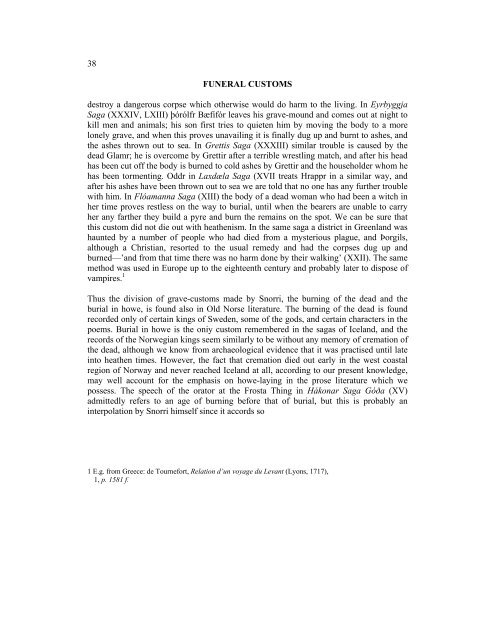Road To Hel - Rune Web Vitki
Road To Hel - Rune Web Vitki
Road To Hel - Rune Web Vitki
Create successful ePaper yourself
Turn your PDF publications into a flip-book with our unique Google optimized e-Paper software.
38<br />
FUNERAL CUSTOMS<br />
destroy a dangerous corpse which otherwise would do harm to the living. In Eyrbyggja<br />
Saga (XXXIV, LXIII) þórólfr Bæfifór leaves his grave-mound and comes out at night to<br />
kill men and animals; his son first tries to quieten him by moving the body to a more<br />
lonely grave, and when this proves unavailing it is finally dug up and burnt to ashes, and<br />
the ashes thrown out to sea. In Grettis Saga (XXXIII) similar trouble is caused by the<br />
dead Glamr; he is overcome by Grettir after a terrible wrestling match, and after his head<br />
has been cut off the body is burned to cold ashes by Grettir and the householder whom he<br />
has been tormenting. Oddr in Laxdæla Saga (XVII treats Hrappr in a similar way, and<br />
after his ashes have been thrown out to sea we are told that no one has any further trouble<br />
with him. In Flóamanna Saga (XIII) the body of a dead woman who had been a witch in<br />
her time proves restless on the way to burial, until when the bearers are unable to carry<br />
her any farther they build a pyre and burn the remains on the spot. We can be sure that<br />
this custom did not die out with heathenism. In the same saga a district in Greenland was<br />
haunted by a number of people who had died from a mysterious plague, and Þorgils,<br />
although a Christian, resorted to the usual remedy and had the corpses dug up and<br />
burned—’and from that time there was no harm done by their walking’ (XXII). The same<br />
method was used in Europe up to the eighteenth century and probably later to dispose of<br />
vampires. 1<br />
Thus the division of grave-customs made by Snorri, the burning of the dead and the<br />
burial in howe, is found also in Old Norse literature. The burning of the dead is found<br />
recorded only of certain kings of Sweden, some of the gods, and certain characters in the<br />
poems. Burial in howe is the oniy custom remembered in the sagas of Iceland, and the<br />
records of the Norwegian kings seem similarly to be without any memory of cremation of<br />
the dead, although we know from archaeological evidence that it was practised until late<br />
into heathen times. However, the fact that cremation died out early in the west coastal<br />
region of Norway and never reached Iceland at all, according to our present knowledge,<br />
may well account for the emphasis on howe-laying in the prose literature which we<br />
possess. The speech of the orator at the Frosta Thing in Hákonar Saga Góða (XV)<br />
admittedly refers to an age of burning before that of burial, but this is probably an<br />
interpolation by Snorri himself since it accords so<br />
1 E.g. from Greece: de <strong>To</strong>urnefort, Relation d’un voyage du Levant (Lyons, 1717),<br />
1, p. 1581 f.
















